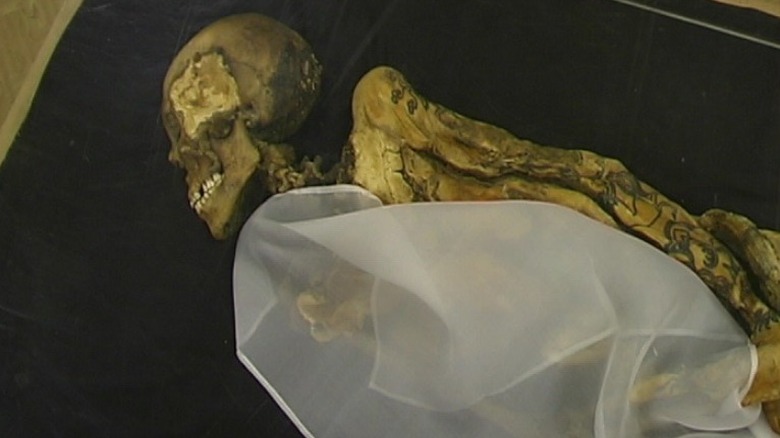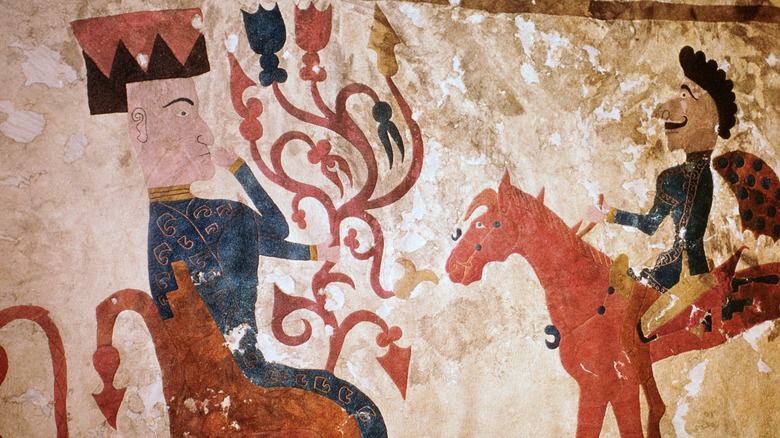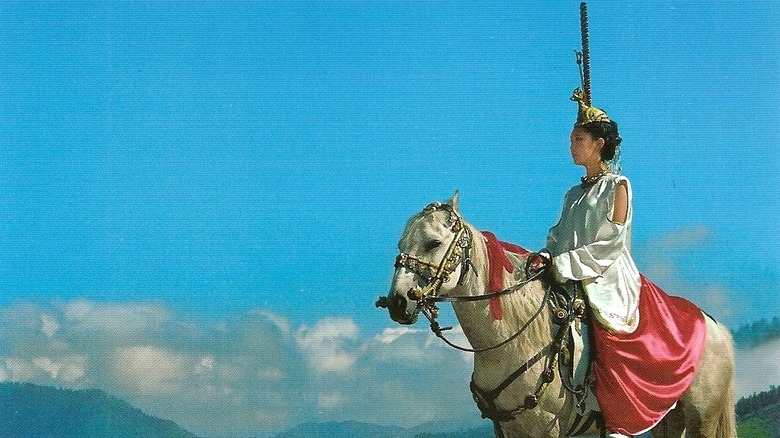The Story Of Siberia's Mysterious Ice Maiden
The Ukok Plateau in Russia (pictured above) is a stunning, glacier-carved expanse of grasses and water-and-wind-worn hills. Located smack dab at the intersection of Mongolia, China, Kazakhstan, and the Russian steppes, this "crossroad of civilizations" cuts through the modern Republic of Altai and has been home to countless indigenous peoples, ethnic groups, and nomadic tribes going back thousands of years, as Russia Beyond explains. As part of Siberia — the imposing expanse of Russian land that composes 57% of the country's landmass (also per Russia Beyond) — Altai produces nothing less than the hardiest of people with a deep sense of respect for the natural world.
In short, the Ukok Plateau is the perfect resting spot for the shaman of remote antiquity, the "Ice Maiden." As The Siberian Times reveals, the Ice Maiden was discovered in 1993 by Russian archaeologist Natalya Polosmak, embalmed and preserved in the permafrost. She was encased in a wooden coffin "in a sleeping position," head shaved, dressed in Chinese silk and body filled with herbs and roots. In this ritual burial, she was surrounded by six bridled and saddled horses, meals of sheep and horse, ornaments of felt, wood, bronze and gold, and much more. Tattoos of mystical, magical creatures were also inscribed into her flesh.
At best guess, she was buried around B.C.E. 500 when she was between 25 and 28 years old. Her cause of death is unknown, although it wasn't due to an injury. And since her discovery, she's become the center of ethno-nationalist controversy amongst the Altaian people.
Tattooed with mystical creatures
The Ice Maiden's tattoos stand at the forefront of her mystery and mystique. Both of her arms, from shoulders to wrists, are covered in swirly designs of magical, four-legged creatures, as The Siberian Times describes. The tattoos on her left shoulder are the best preserved, and Academician Vyacheslav Molodin noted that they include "a deer with a griffon's beak and a Capricorn's antlers" and below it "a sheep with a snow leopard by its feet." There's also an antlered stag's head on her wrist and more tattoos on her fingers. They were all done in indigo ink, with the animals' hair, hooves, horns, and tails unfurling into flower and flame shapes (per The Moscow Times).
As Pazyryk Tattoo Design illustrates and explains on Imgur, these kinds of tattoo designs were cut from felt and soaked in vegetable dye. They were then draped on the skin to curve around limbs. It's not an exaggeration to say that the figures wouldn't look out of place in a modern, stylish tattoo studio.
We know that the Ice Maiden was a shaman due to a number of factors. She wasn't buried with weapons, which means she wasn't a warrior. She also wasn't buried with a mate, which indicates that she'd taken a vow of celibacy. Also, as Russia Beyond says, chemical analyses indicate that she periodically inhaled copper and mercury fumes, which points to a ritual ceremony. Plus, she was wearing a tall, 35-inch headdress, and as previously mentioned, her body was filled with herbs and roots.
Shaman of Scythian warrior-nomads
All evidence indicates that the Ice Maiden belonged to the Pazyryk culture of the Scythian nomadic tribes in the Altai mountains of Siberia in the 6th to 3rd centuries B.C.E., as Russia Beyond explains. Scythians were horseback-riding warrior-nomads who moved around between Eastern Europe and the steppes of central Asia. They herded and lived in mobile wagons. Historians such as Herodotus in the 5th century described them raiding while traveling to and from the Black Sea, Assyria in the Middle East, and more, as World History overviews.
Despite sometimes being called the "Ice Princess," it's not accurate to say that the maiden was a noble. Her tomb wasn't located in the same area as nobles' tombs, and even though there's quite a bit of wealth and prestige on display, it's not as much as the truly wealthy. This means that she likely came from a "middle layer of the Pazyryk society," as Russia Beyond puts it.
According to Historic Mysteries, the Ice Maiden's body was embalmed in bark and peat, although she wasn't wrapped to protect against the heat and elements like Egyptian mummies. Peat bogs are one of historians' greatest allies, as they nearly perfectly preserve artifacts — even entire bodies like the Tollund Man, a "bog body" that was discovered in Silkeborg, Denmark, in 1950. He was executed and tossed in a bog around 400 B.C.E., about a century after the Ice Maiden lived. Impressively, his body is almost perfectly preserved (via Live Science).
Focal point of an ethnic conflict
The Ice Maiden has been the source of quite the controversy since being unearthed. The Altaian people living on the Ukok Plateau fought to have her returned to the region from the moment she was transported away to the Archaeological and Ethnographic Institute of Novosibirsk, per The Siberian Times. It was even rumored that she was stored in a former cheese refrigerator that caused her body to grow fungus.
Altai locals claim that natural disasters, forest fires, high winds, suicides, illnesses, earthquakes, and even helicopter crashes struck the region after the Ice Maiden was taken away. "There are places here that it is considered a great sin to visit, even for our holy men. The energy and the spirits there are too dangerous," one local stated, continuing, "Every kurgan [burial mound] has its own spirit ... and people here have suffered much misfortune since the Ice Princess was disturbed." Another local said, "She may be a mummy, but her soul survives, and they say a shaman communicated with her, and she asked to go home."
The situation is complicated by ethnic issues between local Altai — often of Mongolian descent — and Russian authorities, who state that the Ice Maiden is Caucasian. (Ancient descriptions, such as those on World History, indicate that Scythians had blue eyes, red hair, and Caucasian features.)
In 2012, the Ice Maiden was moved to a mausoleum at the Republican National Museum in Gorno-Altaisk in the Altai region.



